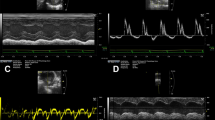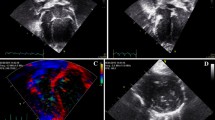Abstract
Objective: Doppler-echocardiography of the mouse has evolved to a commonly used technique in the past years as recent advances in imaging quality have substantially improved spatial and temporal resolution allowing the adaptation of this technique to murine models. Although mouse echocardiography is widely used, there is only little information on reference data for wild-type animals available, particularly in older mice.
Methods: We therefore established a database with echocardiographic reference-values in a large set of young (8 weeks) and older adult (52 weeks) Swiss type CD1-mice of either sex. We performed a complete Doppler-echocardiographic examination under light Ketamine-Xylazine-anesthesia. LV-mass was calculated and compared with necropsy heart weights to validate the LV-mass calculation.
Results: Doppler-echocardiographic measurements in mice were feasible to assess cardiac morphology and function. Sonomorphological and functional parameters hardly changed between the age of 12 and 52 weeks. Wall thickness, LV-mass and cardiac output were stable with aging. There was a good relative correlation between echocardiographically estimated LV-mass and necropsy heart weight although absolute values differed. There were no significant echocardiographic differences between male and female mice.
Conclusions: The reference values established in this study can be useful in recording and quantifying pathological changes in murine models of cardiovascular diseases. There is hardly any change of cardiac function between the age of 12 and 52 weeks.
Similar content being viewed by others
Abbreviations
- Ao maxPG:
-
Maximal pressure gradient aortic valve
- AoVmax:
-
Maximal flow velocity aortic valve
- AW:
-
Anterior wall of the LV
- A-wave:
-
Maximum late flow velocity mitral valve
- BW:
-
Body weight
- CI:
-
Cardiac index
- CO:
-
Cardiac output
- E-wave:
-
Maximum early flow velocity mitral valve
- FS:
-
Fractional shortening
- HW:
-
Heart weight
- LA:
-
Left atrium
- LV:
-
Left ventricle
- LV-EF:
-
LV ejection fraction
- LVET:
-
LV ejection time
- LVEDD:
-
LV end diastolic diameter
- LVESD:
-
LV end systolic diameter
- LVM:
-
LV mass
- LVM-I:
-
LV mass-index
- LVOT:
-
Left ventricular outflow tract
- MV:
-
MaxPG maximal pressure gradient mitral valve
- PW:
-
Posterior wall of the LV
References
Collins KA, Korcarz CE, Lang RM (2003). Use of echocardiography for the phenotypic assessment of genetically altered mice. Physiol Genomics 13(3): 227–239
Fentzke RC et al., (1997). Evaluation of ventricular and arterial hemodynamics in anesthetized closed-chest mice. J Am Soc Echocardiogr 10(9): 915–925
Sahn DJ et al., (1978). Recommendations regarding quantitation in M-mode echocardiography: results of a survey of echocardiographic measurements. Circulation 58(6): 1072–1083
Kiatchoosakun S et al., (2002). Assessment of left ventricular mass in mice: comparison between two-dimensional and M-mode echocardiography. Echocardiography 19(3): 199–205
Collins KA et al., (2001) Accuracy of echocardiographic estimates of left ventricular mass in mice. Am J Physiol Heart Circ Physiol, 280(5): H1954–H1962
Youn HJ et al., (1999). Two-dimensional echocardiography with a 15-MHz transducer is a promising alternative for in vivo measurement of left ventricular mass in mice. J Am Soc Echocardiogr 12(1): 70–75
Tiemann K et al., (2003). Increasing myocardial contraction and blood pressure in C57BL/6 mice during early postnatal development. Am J Physiol Heart Circ Physiol 284(2): H464–H474
Yang XP et al., (1999). Echocardiographic assessment of cardiac function in conscious and anesthetized mice. Am J Physiol 277(5 Pt 2): H1967–H1974
Strauch OF et al., (2003). Cardiac and ocular pathologies in a mouse model of mucopolysaccharidosis type VI. Pediatr Res 54(5): 701–708
Thomas JD (1998). The DICOM image formatting standard: its role in echocardiography and angiography. Int J Card Imaging 14(Suppl 1): 1–6
Du XJ, et al., (2000). Age-dependent cardiomyopathy and heart failure phenotype in mice overexpressing beta(2)-adrenergic receptors in the heart. Cardiovasc Res 48(3): 448–454
Roth DM et al., (2002). Impact of anesthesia on cardiac function during echocardiography in mice. Am J Physiol Heart Circ Physiol, 282(6): H2134–H2140
Hart CY, Burnett JC, Jr, Redfield MM (2001) Effects of avertin versus xylazine-ketamine anesthesia on cardiac function in normal mice. Am J Physiol Heart Circ Physiol 281(5): H1938–H1945
Desai KH et al., (1997). Cardiovascular indexes in the mouse at rest and with exercise: new tools to study models of cardiac disease. Am J Physiol 272(2 Pt 2): H1053–H1061
Fatkin D et al., (2000). An abnormal Ca(2+) response in mutant sarcomere protein-mediated familial hypertrophic cardiomyopathy. J Clin Invest 106(11): 1351–1359
McConnell BK et al., (2001). Comparison of two murine models of familial hypertrophic cardiomyopathy. Circ Res 88(4): 383–389
Stypmann J et al., (2002). Dilated cardiomyopathy in mice deficient for the lysosomal cysteine peptidase cathepsin L. Proc Natl Acad Sci USA 99(9): 6234–6239
Li YY et al., (2000). Myocardial extracellular matrix remodeling in transgenic mice overexpressing tumor necrosis factor alpha can be modulated by anti-tumor necrosis factor alpha therapy. Proc Natl Acad Sci USA 97(23): 12746–12751
Hoit BD et al., (2002). Naturally occurring variation in cardiovascular traits among inbred mouse strains. Genomics 79(5): 679–685
Ghanem A, et al. Echocardiographic assessment of left ventricular mass in mice – Accuracy of different echocardiographic methods. Echocardiography, in press.
D’Angelo DD et al., (1997) Transgenic Galphaq overexpression induces cardiac contractile failure in mice. Proc Natl Acad Sci USA, 94(15): 8121–8126
Vatner DE et al., (2000) Determinants of the cardiomyopathic phenotype in chimeric mice overexpressing cardiac Gsalpha. Circ Res 86(7): 802–806
Harada K et al., (1998). Pressure overload induces cardiac hypertrophy in angiotensin II type 1A receptor knockout mice. Circulation 97(19): 1952–1959
Hoit BD et al., (1997) In vivo determination of left ventricular wall stress-shortening relationship in normal mice. Am J Physiol 272(2 Pt 2): H1047–H1052
Taffet GE et al., (1996) Noninvasive indexes of cardiac systolic and diastolic function in hyperthyroid and senescent mouse. Am J Physiol 270(6 Pt 2): H2204–H2209
Oberst L et al., (1998) Dominant-negative effect of a mutant cardiac troponin T on cardiac structure and function in transgenic mice. J Clin Invest 102(8): 1498–1505
Lewis JF, Maron BJ (1992) Cardiovascular consequences of the aging process. Cardiovasc Clin 22(2): 25–34
Shioi T et al., (2000) The conserved phosphoinositide 3-kinase pathway determines heart size in mice. Embo J 19(11): 2537–2548
Iwase M et al., (1997) Cardiomyopathy induced by cardiac Gs alpha overexpression. Am J Physiol, 272(1 Pt 2): H585–H589
Zvaritch E et al., (2000) The transgenic expression of highly inhibitory monomeric forms of phospholamban in mouse heart impairs cardiac contractility. J Biol Chem 275(20): 14985–14991
Williams RV et al., (1998) End-systolic stress-velocity and pressure-dimension relationships by transthoracic echocardiography in mice. Am J Physiol, 274(5 Pt 2): H1828–H1835
Schmidt AG et al., (2000). Cardiac-specific overexpression of calsequestrin results in left ventricular hypertrophy, depressed force-frequency relation and pulsus alternans in vivo. J Mol Cell Cardiol 32(9): 1735–1744
Fentzke RC et al., (2001) The left ventricular stress-velocity relation in transgenic mice expressing a dominant negative CREB transgene in the heart. J Am Soc Echocardiogr 14(3): 209–218
Manning WJ et al., (1994) In vivo assessment of LV mass in mice using high-frequency cardiac ultrasound: necropsy validation. Am J Physiol 266(4 Pt 2): H1672–H1675
Fard A et al., (2000). Noninvasive assessment and necropsy validation of changes in left ventricular mass in ascending aortic banded mice. J Am Soc Echocardiogr 13(6): 582–587
Liao Y et al. (2002) Echocardiographic assessment of LV hypertrophy and function in aortic-banded mice: necropsy validation. Am J Physiol Heart Circ Physiol 282(5): H1703–H1708
Esposito G et al., (2000) Cellular and functional defects in a mouse model of heart failure. Am J Physiol Heart Circ Physiol, 279(6): H3101–H3112
Semeniuk LM, Kryski AJ, Severson DL (2002) Echocardiographic assessment of cardiac function in diabetic db/db and transgenic db/db-hGLUT4 mice. Am J Physiol Heart Circ Physiol 283(3): H976–H982
Bruch C et al., (1999) Tissue Doppler imaging (TDI) for on-line detection of regional early diastolic ventricular asynchrony in patients with coronary artery disease. Int J Card Imaging 15(5): 379–390
Slotwiner DJ et al., (1998). Relation of age to left ventricular function in clinically normal adults. Am J Cardiol 82(5): 621–626
Aessopos A et al., (2004). Cardiovascular adaptation to chronic anemia in the elderly: an echocardiographic study. Clin Invest Med 27(5): 265–273
Lakatta EG (1990). Changes in cardiovascular function with aging. Eur Heart J, 11(Suppl C): 22–29
Author information
Authors and Affiliations
Additional information
*Jörg Stypmann, Markus A. Engelen contributed equally to this work. ** Parts of these data are part of C. Epping’s doctoral thesis.
Address for correspondence: Dr. med. Jörg Stypmann, Medizinische Klinik und Poliklinik C, Kardiologie und Angiologie, Universitätsklinikum Münster, Albert-Schweitzer-Str. 33, D-48149 Münster, Germany Tel.: +49-251-83-47617; Fax: +49-251-83-47684; E-mail: stypmann@mednet.uni-muenster.de
Rights and permissions
About this article
Cite this article
Stypmann, J., Engelen, M.A., Epping, C. et al. Age and gender related reference values for transthoracic Doppler-echocardiography in the anesthetized CD1 mouse. Int J Cardiovasc Imaging 22, 353–362 (2006). https://doi.org/10.1007/s10554-005-9052-9
Received:
Accepted:
Published:
Issue Date:
DOI: https://doi.org/10.1007/s10554-005-9052-9




